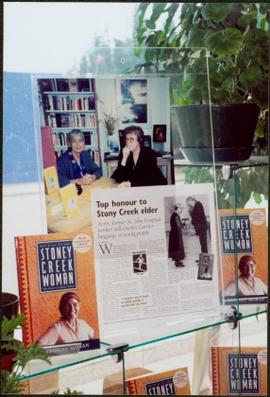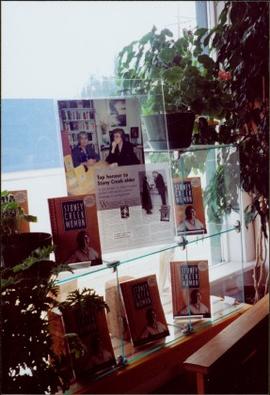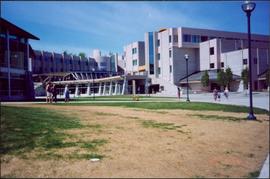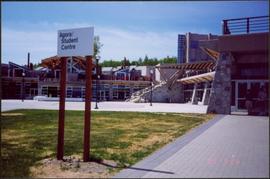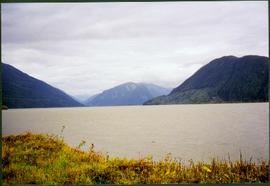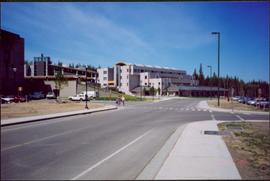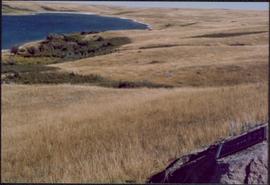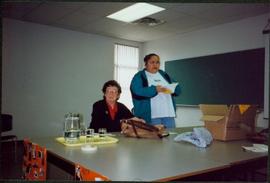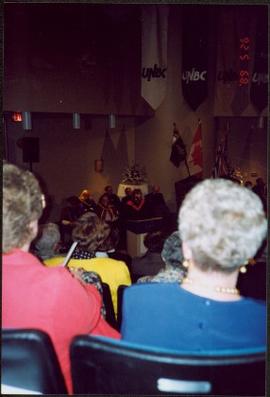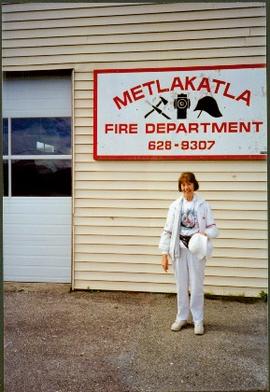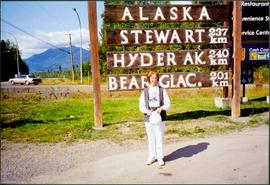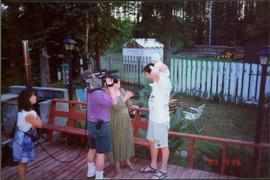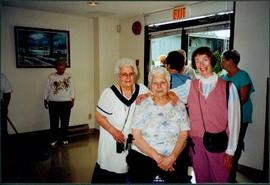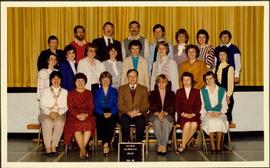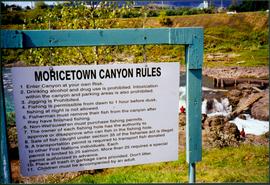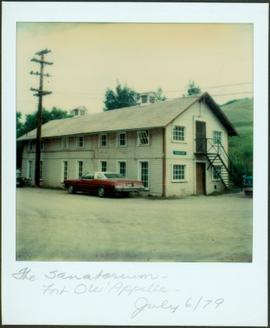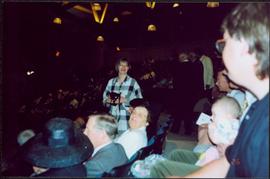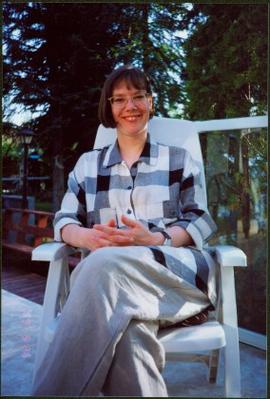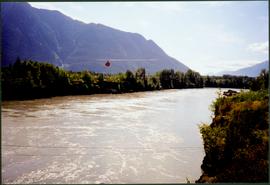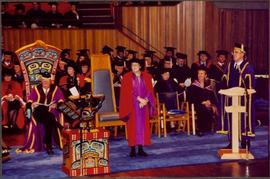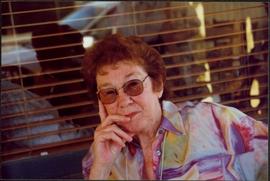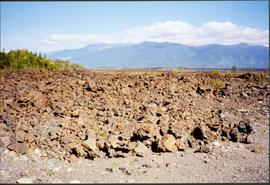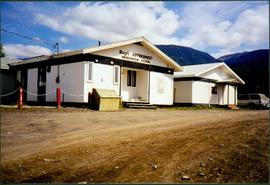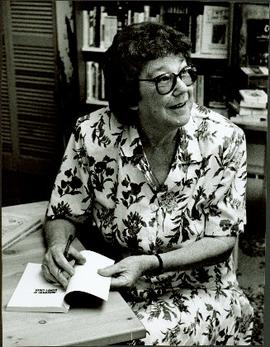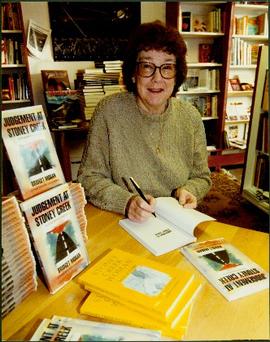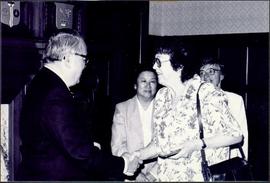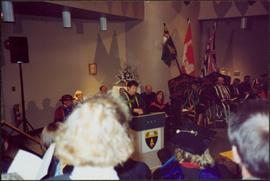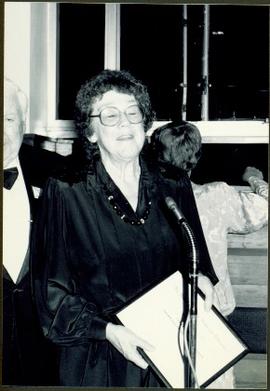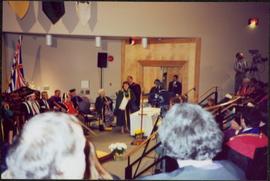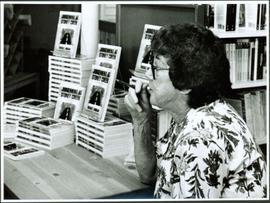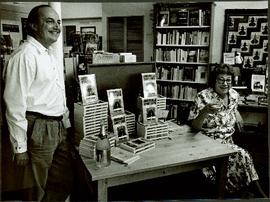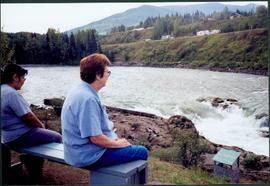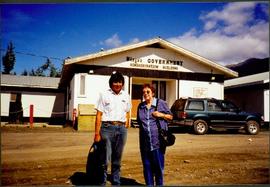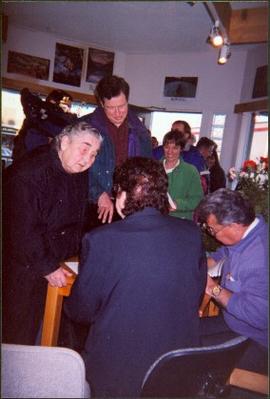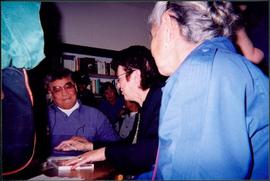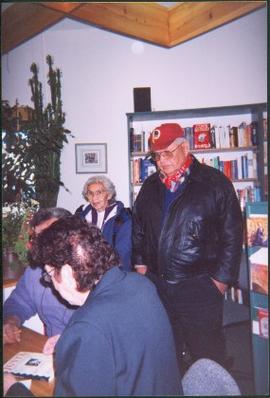Photograph depicts numerous copies of 'Stoney Creek Woman' (by Bridget Moran) in glass case. Display also features article on Mary John's receipt of the Order of Canada (see items 2008.3.1.22.61 and 2008.3.1.22.64 for photographs displayed in this image).
Photograph depicts numerous copies of 'Stoney Creek Woman' (by Bridget Moran) in glass case. Display also features article on Mary John's receipt of the Order of Canada (see items 2008.3.1.22.61 and 2008.3.1.22.64 for photographs displayed in this image).
Audio recording consists of Bridget Moran reading chapter excerpts from her manuscript “Where Words Come Sweet” [later title of manuscript is “The Horizontal Land” which tells the tale of the Doonan family, Kate who Bridget notes “developed as a volatile woman, quick to anger, quick to tears” and her husband Charlie, a “classic quiet Irishman, in fact, rather like my own father” and their children who emigrate to the South Saskatchewan River country in September 1924. As Moran describes in a letter “in short, my novel is a rather light-hearted, hopefully, authentic look at the Saskatchewan of 1924. I was at pains to avoid the dust storm-grasshopper-flat terrain syndrome, and instead to portray the beauty of south Saskatchewan as I knew it, the wonderful blend of ethnic groups, and the richness in character of the people who have lived there.”
Audiocassette Summary
Side 1
Title: Where Words Come Sweet #1
Scope and Content: Bridget Moran reads a chapter from her story entitled “Where Words Come Sweet”. The account of the Doonan family – Charlie and Kate and their children living in the pre-Depression era on the Canadian Prairies
- Kate immerses herself in the Catholic church and its rituals
- Priest Father Boncoeur talks about generosity of those who donate to the Church
- Charlie has difficulty with the Church asking for money same as in Ireland and leaves the Church because of it;
- Conflict between Charlie & Kate regarding religion
- Prairie winter blizzard described
- End of chapter
In this audio segment Bridget reads excerpt from Chapter 17 “Hail Mary, Full of Grace” which provides the account of Father Duroc who Bridget notes in the chapter synopsis “reads out the contributors and the contributions to the church, leading to war in the Doonan household.” And of Kate’s immersion in the Catholic faith and its rituals
Side 2
Title: Where Winds Come Sweet #2
Scope & Content: Bridget Moran explains that the inspiration for the title of the manuscript, Where Winds Come Sweet was derived from a poem by Pauline Johnson – Harvest Time. Bridget proceeds to read the poem. Then Bridget describes the main characters and provides a brief synopsis: The story of an Irish Catholic family, the Doonans, who came from Ireland, originally to Ontario and then to the South Saskatchewan River country in 1924. Bridget describes the characters: Kate & Charlie Doonan, and their kids: Kevin, Patty, Mick, Bridie, Mary, and J.T. She also describes two other characters Barney and Gladys Mullins– caretakers. Bridget reads a version of the chapter “The Teacher Cometh” – noted on audio recording as Chapter 7 [in a later version of this manuscript from November 1981 this chapter is Chapter 14]. The chapter describes the coming of a school teacher Miss Doris Sutton who makes life difficult for the residents – specifically the women folk as the men in the community come to be enamoured with her. This chapter describes how Kate overcomes her dislike for the teacher Miss Sutton, how she spends a weekend with the Doonans and how they become friends.
Bridget then provides a synopsis of another chapter that she entitles on the recording as “Unholy Deadlock” In a later version of the manuscript from November 1981 this chapter is entitled “Give Us This Day” Chapter 16 and describes how Father Duroc arrives in the community in January 1925 and stays with the French Canadian family the Bouchard’s]
In the next audio segment Bridget reads excerpt from Chapter 17 “Hail Mary, Full of Grace” which provides the account of Father Duroc who Bridget notes in the chapter synopsis “reads out the contributors and the contributions to the church, leading to war in the Doonan household.”
Photograph depicts white rapids at bottom of waterfall in Bulkley River, B.C. Fishing territory visible on far right; hill on opposite shore in background.
Photograph depicts water in foreground, bayside village in background.
Photograph depicts the Agora center at the University of Northern British Columbia in Prince George, B.C. Library building can be seen in right background, cafeteria building on far left. Unidentified individuals can be seen walking on campus. Accompanying note from Maureen Faulkner: "The processional gathers on the upper walkway". Photo believed to have been taken on the day Bridget Moran received an Honourary Law Degree.
Photograph depicts the Agora center at the University of Northern British Columbia in Prince George, B.C. Sign in foreground reads "Agora/Student Centre". Unidentified individuals can be seen in red blankets on upper walkway in background, above the Winter Garden. Accompanying note from Maureen Faulkner: "The first nations people, in button blankets, gather". Photo believed to have been taken on the day Bridget Moran received an Honourary Law Degree.
Photograph depicts unknown lake. Grassy shore in foreground, mountains in background.
Photograph depicts road at University of Northern British Columbia. Library building stands in center background. Administration and cafeteria buildings can be seen in left background. Accompanying note from Maureen Faulkner: "Walking up to Canada's newest 'U' - ". Photo believed to have been taken on the day Bridget Moran received an Honourary Law Degree.
Photograph depicts lake in surrounding field. Grave marker on rock in right foreground. Handwritten annotation on recto of photograph: "This is a picture of the lake (part of it) the rock is in the bottom right corner on a knoll. You can see the plaque on it. But it isn't very clear."
Photograph depicts Bridget Moran seated beside unidentified woman who stands reading excerpt from Moran's book. Table with miscellaneous items in foreground, window and chalkboard in background. (Standing woman also featured in item 2008.3.1.102.5).
Photograph depicts woman at podium, individuals in regalia seated behind her against background wall. Audience sits in foreground in the Canfor Theatre at the University of Northern British Columbia in Prince George, B.C. Accompanying note from Maureen Faulkner: "Young Dr ___ as she introduces you. In front of me are 2 of my senior admin team - John Stevens & Jim [Emrich?] & their wives." Photo taken on the day Bridget Moran received an Honourary Law Degree.
Woman stands in front of building with the sign "METLAKATLA FIRE DEPARTMENT 628-9307". Garage door visible on left.
Woman stands in front of sign that reads "ALASKA / STEWART 237 km / HYDER AK. 240 km / BEAR GLAC. 201 km". Second sign in background indicates restaurant, convenience store, and service centre. Car, road, and highway can be seen in midground; mountains in background. (This woman is also featured in item 2008.3.1.22.13).
Photograph depicts Moran standing between cameraman and son Pat (who holds infant) on deck in backyard. Trees, fence, and neighbouring yard in background. Accompanying note from Maureen Faulkner: "T.V. Camera & crew documents you, your life & family." Photo taken on the day Bridget Moran received an Honourary Law Degree from the University of Northern British Columbia in Prince George, B.C.
Photograph depicts fishing territory at waterfall rapids in Bulkley River, B.C. Highway and buildings on opposite shore in background.
Photograph depicts an unidentified individual standing on cliff above waterfall at Bulkley River, B.C. Fishing territory visible below; highway, buildings, and hills visible in background.
Photograph depicts three elderly women posing together for photograph. Six other women visible in building; second building can be seen through door in background.
Item is a audio interview recorded by Bridget Moran with Justa Monk.
Audiocassette Summary
00’ 10” Moran asks Theresa about when she first started living with Justa. They discuss the beginning of their relationship. Theresa discusses her former husband, how she began drinking because of his abuse. She says Justa made her settle down.
11’ 22” Moran asks Theresa about the things her and Justa do together. She says they garden. She says he looks after her well, but in the past Justa ‘slapped her around’ when they were drinking. Theresa talks about her past with alcoholism and how it affected her relationship with Justa.
18’ 30” Moran asks about when Justa and Theresa got married. Theresa talks about the wedding. Theresa talks about how Justa’s parents initially did not accept her, but they eventually started to treat her well when they saw Justa and her were doing well.
21’ 35” Moran asks Theresa about her children. Theresa discusses them all individually. Two of her daughters were killed.
31’ 45” Moran asks Theresa about going to Tachie for salmon fishing. Theresa talks about the process of fishing from the shore. Theresa also talks about hunting and preparing for the winter.
37’ 45” Moran tells Theresa no names will be mentioned in the book, such as the last name of her first husband.
37’ 59” Moran asks Theresa why she thinks alcoholism is such a problem on the reserves nowadays.
42’ 59” End of tape.
Item is a recorded audio cassette: Side A: The Plot Thickens, Oct. 31/87; Side B: Patrick: Sandblast, Aug/86
Audiocassette Summary
SIDE 1 - Title: “The Plot Thickens” - Oct. 31, 1987
- 00:04 Tape recording of an FM radio broadcast entitled “The Plot Thickens” featuring an announcer reading the winning entry for short fiction in the adult category. The title of the story is “The Case of the Box of Matches” by Bridget Moran who was then announced as the 1st prize winner in “The Plot Thickens”: her prize was a copy of The Illustrated History of Canada. Transcript available in 2008.3.1.81, along with a copy of a cover letter she sent in to the radio station for this contest. (Oct. 31, 1987)
- 03:03 Bridget Moran reading a story she wrote about quitting smoking, entitled “My Old Flame” Transcript available. Some significant differences noted between available transcript and tape recording. (ca. 1987) This story was published in the Saturday Review of The Vancouver Sun, February 22, 1992 as “The grief of giving up my long-time comfort”. Copy of the article available in 2008.3.1.81.
- 11:39 Tape recorded music (various)
- 45:40 End of Side 1
SIDE 2 - Title: Patrick – Sand Blast, Aug/86
- 45:44 Pre-lunch CI Radio interview: Leanne (?) with Patrick Moran re: 15th Annual Sandblast. He raced in Sandblast for 6 years and involved with the organization for 3 years. He got into it from his love of skiing. Pre-race organizers go through the course and clean away the rocks and obstacles as best they can. [The rough course] doesn’t scare him. To consider entering this event: need to be confident skier; to wear heavy pants for protection on legs and arms, helmet and pair of gloves; keep your head about you – it’s lots of fun. Discussion that some of the falls are very spectacular to watch. Time on Sunday: skier registration at 10am at Kokanee Cutbanks right on the flat bed; racing starting at noon. Concession and toilet facilities and parking available. Asking spectators to park on the city side of the bank – NRT Ready Mix offered their parking lot for the occasion to help lessen traffic congestion. Big sponsors this year include: Bob Husband and the people at Labatts and Kokanee – without them Sandblast wouldn’t be happening due to liabilities going up. Also a thank you to George and the people at Northern Ski – backbone of Sandblast. Also Pacific Western Airlines – winner will win trip anywhere in Canada. Prizes also include: walkmans, skiing accessories, sports gear, t-shirts, cameras, etc… Divisions of competition include: men’s and women’s slalom; telemark event; and prizes for safety and a helmet; also a hidden time prize. CI radio also donating “Best Time” annual trophy. Saturday night a Pre Blast “Blast”: tix on sale at Northern Ski $12 incl. midnight buffet with door prizes. Doors open 8pm until 2pm at the Kin Sports Centre. Music by Prince George band: Sound Concord, and Lightening Sound. Tix only available in advance. Sandblast t-shirt and dance tix radio giveaway through trivia question: “Who won the men’s 1st prize last year and also the year before” Hint: initials “S.B.”. Pat also mentioned support by RCMP and City of Prince George. No callers so interviewer Leanne answers: Stu Boyce (?) and she promised to give tix away later on the radio. Thanks to Pat Moran.
- 53:18 Tape recorded music (various)
- 01:05:22 Bridget Moran reading a story she wrote about quitting smoking, entitled “My Old Flame” Transcript available. Some significant differences noted between available transcript and tape recording. (ca. 1987) Different reading than that on Side 1. This story was published in the Saturday Review of The Vancouver Sun, February 22, 1992 as “The grief of giving up my long-time comfort”. Copy of the article available in 2008.3.1.81.
- 01:16:25 Tape recorded music (various)
- 01:28:50 End of Side 2
Item is a audio interview recorded by Bridget Moran with Jimmy, Rosie, Nancy, and Madeline.
Audiocassette Summary
00’ 05” Continuation of interview with Jimmy. Jimmy says his grandfather is French, not German, like Justa thinks. Moran and Jimmy continue to talk about the history of his grandparents. Jimmy continues to talk about his family history. They talk about the history of their last name, Monk.
12’ 08” Interview changes to Rosie. Moran asks Rosie about her siblings and other family history. Moran asks about the history of their last name, Monk. She believes her descendants are French. They continue to talk about her family history.
19: 22” Moran asks Rosie about the time Justa murdered John. Rosie talks about the situation candidly. She talks about John’s family life.
26’ 30” Moran asks Rosie about attending residential school. Rosie says school was alright for her, that they looked after them. She came home after six years.
28’ 30” Rosie talks about traveling around with her father because he worked many different jobs.
29’ 55” Rosie talks about getting married, how she got to choose her own partner, instead of having it arranged. She discusses her children.
32’ 05” Moran asks if Rosie had a good childhood. Rosie says yes, but her parents were strict. She remembers her father having to pay a land tax because they did not live on reserve land. She continues to talk about her childhood.
37’ 16” Rosie talks about life in residential school. Nancy says the nuns were kind; that they had to punish them if they spoke their native language.
38’ 50” Interview changes to Nancy. Moran asks about the history of their last name, Monk. They talk about her family history.
45’ 43” Moran asks Nancy about the time Justa killed his brother, John. Nancy talks about what she can remember.
47’ 32” Moran asks Nancy about the death of her brother, Teddy. She tells Moran the story she was told by the police.
49’ 34” Moran asks Nancy when she went to residential school. Nancy talks about having convulsions, so only spent two years there, then came home. When she was feeling better, she went back for another two years. She said her time there was not that bad, but she was homesick and lonely.
53’ 16” Moran asks Nancy if she had a good childhood. Nancy tells her she did, that they did everything for their parents.
56’ 07” Interview changes to Madeline. Moran asks about the history of their last name, Monk. Madeline does not know much about it. They continue to talk about the history of the family.
1:02’ 45” Madeline tells Moran about how she knocked Justa out with a block of ice because he was teasing her when they were children. Justa was a big tease, she says. Madeline says that Justa collected a box full of ‘treasure.’
1:09’ 10” Moran asks Madeline about her mother and how much she sewed for other people.
1: 10’ 44” Moran asks about when Madeline went to residential school. She tells Moran that she liked it there. Those who went there have discipline, she says.
1: 12’ 55” Madeline tells Moran that her parents were strict. She talks about being punished when breaking the rules, much like being at the residential school. They return to discussing residential school.
1: 17’ 55” Moran asks Madeline about what she remembers about the trips between Portage and Fort St. James. She talks about traveling by canoe once with her grandfather.
1: 20’ 33” Moran tells Madeline what she plans to write about in the book, particularly the first chapter dealing with the family history and life before the road being built to Portage.
1: 23’ 25” They return to talking about the family history, including aunts. They talk about her siblings.
1:30’ 07” Moran asks about Justa Hanson, the man Justa was named after. He was living in Tachie at the time Justa was born.
1:32’ 40” End of tape.
Item is a audio interview recorded by Bridget Moran with Justa Monk's family members.
Audiocassette Summary
00’ 05” Moran is talking to Justa’s sister, Adelle. She says the old way of life is better than life today. They talk about the lack of gardens in Tachie today.
02’ 45” Adelle talks about the family history, particularly her father. She talks about their way of life when they were children. Adelle continues to talk about her past.
08’ 40” Adelle talks about the residential school and how she was upset she was when she was sent there. She talks about being punished for speaking their native language. She was at the residential school until the age of sixteen.
12’ 13” Moran asks Adelle about what she remembers about fishing. She talks about the process of fishing.
13’ 22” Adelle talks about her individual history. She talks about not getting married at all because she could not marry the man she wanted. She talks about getting tuberculosis and being in the hospital for a year. When she was released from the hospital, she moved in with a man who was abusive towards her. She talks about leaving him and moving to Prince George, eventually.
18’ 56” Adelle talks about how it was beneficial that her parents were strict. She continues to talk about her childhood, particularly Christmas.
24’ 36” Moran and Adelle talk about when Justa killed his brother. Adelle tells Moran that Justa looked after his brother’s children after he was released from prison.
26’ 08” Moran asks Adelle about whether she drank or not. Adelle says when she moved to Prince George she began to drink heavily.
27’ 35” Moran asks Theresa about the time her and Justa got married. Adelle tells Moran that Justa was the baby of the family and how his siblings ‘babied’ him, hence why his mother was so upset when he married Theresa.
31’ 00” Interview changes to Theresa’s mother. Theresa’s mother speaks in her native language most of the time and Theresa translates. They talk about her past, particularly where and when she was born. They talk about how many families lived in Tachie.
40’ 13” Moran asks about whether Theresa’s mother went to Fort St. James often before the road was built. When they went to Fort St. James, by horse, they would buy some groceries.
43’ 04” They continue to talk about Theresa’s mother’s past.
47’ 33” Moran interviews Jimmy, Justa’s brother. She begins by asking him with the road being built. He tells her life was better in the old days because it was cheaper.
50’ 10” Moran asks about the family history. Jimmy lists the siblings from oldest to youngest.
52’ 05” Jimmy tells Moran that he did not go to the residential school because his grandfather would not let him. Jimmy needed to work for the family because he was the oldest. He talks about everything being done by hand.
58’ 00” Moran asks Jimmy about the type of house that his parents lived in when he was born. He talks about his childhood and his way of life. He talks about helping building a house with his father that had no rooms.
1: 02” 53” Moran asks Jimmy when he got married. Jimmy talks about his wife’s family, particularly his father-in-law, who Justa was named after.
1: 04’ 58” Moran asks Jimmy his memories about living in Portage. He tells her he was a bad kid. He also talks about the trips he took to the surrounding areas. He tells her it was a hard life, but there were good things.
1:10’ 35” Moran asks Jimmy about any memories he has of Justa as a kid. Jimmy tells her that even as a kid, Justa was pretty smart. Jimmy would take him to collect hay. Justa was called the baby and was spoiled too much.
1: 13’ 09” Moran asks Jimmy where he was when Justa got in trouble with his brother. Jimmy said he had a feeling something bad was going to happen, so decided to go home. He talks about when he was told about the murder. Moran continues to ask about the situation, but Jimmy tells her he is still not sure what happened between Justa and John.
1:25’ 03” Jimmy talks about making his store bigger at the pressure of Indian Affiars, but it was too much to keep operating, so now there is only a store that sells junk food.
1:28’ 47” Jimmy talks about the loss of two of his children. He continues to discuss his children.
1: 34’ 36” End of tape.
Audio cassette contains a recorded interview with Bridget Moran for a Social Work class, possibly at UNBC, with questions asked by the instructor and individual students.
Audiocassette Summary
Context: Interview with Bridget Moran for a Social Work class [UNBC?] with questions asked by instructor [Rosalie?] and individual students
Scope and Content:
- Interviewer asks what kept Bridget in social work? – “Not a profession but an addiction”
- Possibility of addiction to social work possibly contributed to the breakup of her marriage – “married a charming Irishman who could not keep his charm at home”
- Likes to take the pain of the job home
- Social work students sometimes afraid to get emotionally involved
- “translate your private concerns into public actions”
- Social workers have to be aware of First Nations culture
- Social workers need to a part of the society in which they are living; Bridget could relate because she was on welfare when she was a child
- Psychologically prepared for the repercussions of her social actions towards the W.A.C. Bennett government; Bridget notes her actions reflected the frustrations of the group of social workers in Prince George at the time – but that she didn’t involve anyone else – if it had it might have been more successful
- Important to provide a sense of empowerment to your social work clients
- Speaks about the response to her book A Little Rebellion
- Speaks about how the book Stoney Creek Woman was initiated by Mary John’s daughter Helen
- Speaks about how the inquest into the death of Coreen Thomas, inspired her to write Judgment at Stoney Creek
- Discusses her book about Justa Monk
- Native people can only “heal themselves through their own culture”
- Discusses her Writers Workshop series
- Re: Oath of confidentiality – ethical dilemmas for social workers - Didn’t mean to break her oath of office but because she did violate it [in the governments view] therefore felt she had to resign
Photograph depicts group of 23 men and women posed for photo in gymnasium. Plaque in foreground reads "QUINSON ELEMENTARY STAFF 1985 86". Bridget Moran stands third from left in middle row.
Item is a recording of an interview that Bridget Moran conducted with Elder Sophie Thomas and Elder Mary John on the circumstances surrounding the death of her niece, Coreen Gay Thomas who was hit by a car in Stoney Creek in 1976 by a white man. During the interview they are joined by Elder Mary John who also answers questions about Coreen’s death. In the remainder of the interview Bridget asks Sophie about her own life; Sophie talks about being “married off” at 16 years of age; and experiences at the residential school at LeJac.
Audiocassette Summary
Side 2
00’05” Moran asks Sophie about the night that Coreen died and how Sophie learned the news
06’00” Sophie explains who came and told her the news. Sophie describes having to go to the morgue and assisted the nurses in preparing Coreen’s body for burial before being brought back to the reserve for the funeral. Sophie recalls telling the youth who were witnesses to the accident to speak the truth when being interviewed by the RCMP.
07’00 Sophie talks about her reaction to hearing that there was not going to be an inquest into Coreen’s death. She talks about her decision to fight against this and recalls how she notified the BC Association of Indian Homemakers requesting its assistance and how it sent a representative member Kitty [Bell] with the BC Indian Homemakers who interviewed Sophie, other Stoney Creek members and accident witnesses and that a letter was sent to the Coroner urging an inquest. Bridget refers to an article in the PG Citizen newspaper quoting Sophie on her desire for an inquest and they discuss the context of this quote. Sophie talks about her encounter with the Judge to request an inquest. She talks about how he [Judge Eric Turner] had himself caused a hit and run accident and how this may have initially been his rationale not to have an inquest into Coreen’s death.
15’00 Bridget asks about how Coreen’s parents found out about the accident and why the RCMP didn’t notify them. Sophie and Mary John discuss the questioning of Coreen’s sister [Marjorie who was with Coreen at the time of the accident] at the RCMP headquarters in Vanderhoof. Mary John joins the interview and Bridget asks her how she found out about Coreen’s death.
20’00 Both Sophie and Mary talk about Coreen, that she attended St. Joseph’s School to Grade 7. They note she babysat for families in the community. Sophie notes that Coreen and her boyfriend were planning to marry after the baby was born as “that was our custom” and had bought their wedding rings. He was at the Williams Lake Stampede at the time of the accident.
Tape turned off momentarily.
24’00 Bridget then interviews Sophie about her own early married life and about getting married at age 16 and the reasoning for this. Sophie explains that she did not want to get married but that the ‘watchman’ [at the Lejac school] insisted she get married as she couldnot remain at the school. Sophie explains that was the ‘school law’ as the school didn’t want to keep them after age 16; Bridget surmises that it may have been the policy of the Department of Indian Affairs so as not to pay for further education. Sophie notes it was 1932 when she married [Maurice Thomas]; that she didn’t know her husband before; that he was 25 years old and from another village. She explains they got married and she spent 2 days at her mother-in-law’s house alone before joining him. They lived in a log cabin on his grandfather’s land.
29’00 Bridget then asks about the role of the ‘watchman’ at the school; about whether the priests (Father Coccola and Father Joseph) thought it was appropriate to marry off young girls. Sophie recalls the time at the school when she ran off; she notes that ‘religion was so strong’ that they had to get married. She recalls the strictness of the school and how pupils were punished by the priests; she refers to some boys being tied down and lashed.
33’00-34’00 Sophie notes her maiden name was George. She recalls how at the time of her wedding that the priest [?] wanted to have a ‘free dance’ for her wedding as entertainment. She remarks how odd the custom was to her; she explains that there is no dancing at a native wedding.
End of Side 2
Photograph depicts sign in foreground outlining rules and restrictions for behaviour at Moricetown Canyon. Traditional fishing territory visible behind sign at waterfall in the Bulkley River, B.C. Highway and buildings can be seen in background.
Polaroid photograph depicting large building with the sign "TRADES SHOP". Power line and red car in foreground; hill and trees in background. Handwritten annotation on verso of photograph: "The Sanatorium. Fort Qu'Appelle - July 6/79".
Photograph depicts Roseanne standing in auditorium aisle in the crowded Canfor Theatre at the University of Northern British Columbia in Prince George, B.C. Family and friends of Bridget Moran believed to be seated in foreground. Photo taken on the day Bridget received an Honourary Law Degree, before ceremony began.
Photograph depicts Bridget Moran's daughter Roseanne sitting in patio chair on deck in backyard. Deck railing in midground, trees in background. Accompanying note from Maureen Faulkner: "Roseanne - elegant." Photo taken on the day Bridget Moran received an Honourary Law Degree from the University of Northern British Columbia in Prince George, B.C.
Photograph depicts wide river with forest shores on either side. Power lines in foreground, mountain in background.
Audio recording consists of speeches and related forum questions at a public forum in Canada (Ottawa?) in post-WWII period. Speaker refers to this as the “post-McCarthy era”. The MC notes that the “CND” founders are on a speaking tour in the U.S., so it is possible this recording is a component of that tour. Speeches appear to be by Canon L. John Collins & Diana Collins who were both organizers of the Campaign for Nuclear Disarmament, an organization founded in 1958, which by 1960 was the largest mass movement in Britain. The CND organizers included philosopher Bertrand Russell, and chair of the Campaign was Canon L. John Collins and his wife Diana Collins. John & Diana Collins speak on the state of protest groups for nuclear disarmament in Britain, U.S. and Canada. The end of forum includes a political motion that the campaign for nuclear disarmament in Canada will renew itself to approach politicians to oppose arms development in Canada whether at home or abroad.
Audiocassette Summary
Side 1
00’01” -4’06” recording starts in progress with speaker possibly Cannon John Collins, chairman of the Campaign for Nuclear Disarmament
4’07-11’25” recording of woman, possibly Mrs. [John] Diana Collins of the CND; answering question from audience on how to stop nuclear war from happening
11’26-21’39” continued speeches; includes position of [Anglican?] church on nuclear disarmament and position of the Canadian Peace Institute
21’40-24’31” motion on nuclear disarmament in Canada; passed.
Photograph depicts many individuals wearing regalia, sitting in positions on convocation stage in Victoria, B.C. Bridget Moran stands in center stage.
Photograph depicts close view of Moran seated in front of window at unknown location. Handwritten annotation on recto of photograph: "July / 1997". Accompanying note reads "[...] also enclosed is a letter sent to you via Marianne & your book that got left behind. Hope you are well & we'd love to see you at our meeting sometime. Regards! Sue [McNeill?]."
Audio recording is an interview by Bridget Moran with Paul Ramsey. At the time of this interview (December 1995) Paul Ramsey was serving in the BC provincial government (NDP) as the Minister of Health and Minister Responsible for Seniors, a post he held from September 1993 to February 1996. Bridget Moran interviews Paul Ramsey on the state of health care in Prince George. Moran notes in the interview that this material is for an article that she is writing on the crisis in health care in Canada.
Audiocassette Summary
- Paul Ramsey discusses why doctors have left Northern BC; specifically the case of orthopedic surgeons leaving Prince George
- Ramsey discusses burnout by physicians, more money in private sector
- Ramsey discusses the impact of a two tier health care system in Canada; the treatment of health care as a ‘consumer good’
- Ramsey compares the Canadian health care system with the U.S. health system
- Discusses specific case of doctors in Prince George – re. the direct billings crisis in 1993
- Ramsey describes changes in medical training; specialists versus general practitioners
- Budget – cost of health care $6.6 billion – 1/3 of provincial expenditures; expecting cuts in health care by spring 1996
- Expands on what he sees as the federal government’s view of universal health care in Canada; including views of individual politicians, both federally and provincially.
- Bridget provides her views on the pitfalls of a two-tier health care system based on personal experiences and family members’ health care history
- Ramsey provides his views on the British Columbia Medical Association
- Ramsey discusses cases of Prince George doctors who started direct billings to patients and settlement of cases
Photograph depicts what appears to be a lava bed, see item 2008.3.1.22.33.
Photograph depicts two white buildings, one with the sign "Nisga'a Government Administration building". Road in foreground, vehicles and hills in background.
Audio recording is of an interview that Bridget Moran conducts with a Mrs. Thompson held in Success, Saskatchewan. Mrs. Thompson talks about municipal politics in the rural town of Success, Saskatchewan when Jimmie (her husband?) was on the Council. Most of the interview relates to Mrs. Thompson’s account of the marital and domestic life Alfie (Guy?) who was another town councilor and known as a local poet.
Audiocassette Summary
Side 1
00’05” Moran asks Mrs. Thompson about the time that Jimmie (her husband?) was on the Council in Success. She recalls when her husband joined the Municipal Council and notes it was for 6-7 years; c.1960s. Bridget asks her to explain the conflict between Jimmie and Alfie (Guy?) who was also on the Success Municipal Council. Bridget refers to Alfie and how he wrote books of poetry.
04’00” Mrs. Thompson recalls Jimmie joining the Council at the time of the municipal conflict about the selling of the Sports ground and that was the time that Colleen [?] also joined the Council. Mrs. Thompson recalls getting involved in the dispute and that she encouraged the community’s women to vote on the issue of this, as well as the assessment role and taxation dispute. Notes that the town was divided “into two camps” on the issue. Also talks about the other issues that Jimmie became involved in including need to better roads in the town.
14’00” Bridget asks her about Alfie and him being a poet. Mrs. Thompson talks about Alfie returning to town after World War II and about his relationship with his first wife Lil. They eventually divorce and he remarried three more times. Most of this section is about his relationship with his second wife.
25’00” Mrs. Thompson notes that Alfie is still alive and is in his 80’s and still writes poetry. She recounts one poem he wrote entitled ‘Town of Purple Gas’ and provides an account of how he was inspired to write this – someone in town was putting an unknown substance in the gas that turned it purple… Bridget notes he was ‘quite the character.’
End of Tape
Photograph depicts Bridget Moran seated at table with copy of her book in hand. Bookshelves visible in background.
Photograph depicts Bridget Moran seated at table covered with copies of 'Judgement at Stoney Creek'. Three copies of 'Stoney Creek Woman' are also displayed on table. Bookshelves in background. Photo believed to have been taken at same location as items 2008.3.1.17.1, 2008.3.1.17.2, and 2008.3.1.19.4.
Handwritten annotation on recto: "Bridget Moran receives the Lieutenant - Governor's Medal for Historical Writing from His Honour David C. Lam in Government House, May 12, 1989." Lieutenant Governor Lam stands in formal attire on left, shaking hands with Moran. Two woman stand in background.
Photograph depicts Moran wearing regalia and standing at podium while reading at the University of Northern British Columbia in Prince George, B.C. Group sits in foreground and background. Flags and speakers can be seen against far wall.
Handwritten annotation on recto: "Bridget Moran thanks the B.C. Historical Federation for recognizing her as best author of 1988." Moran stands behind microphone, holding award. Don Sale and Naomi Miller of the B.C. Historical Federation Writing Competition Committee stand in background.
Photograph depicts Moran wearing regalia and holding an unidentified item in the Canfor lecture theater at the University of Northern British Columbia in Prince George, B.C. Group sits against wall in foreground and in theater seats in background. Flags and speakers can be seen against far wall. Cameras and photographers also visible in image.
Photograph depicts Bridget Moran seated at table covered with copies of her book.
Photograph depicts Bridget Moran seated at table covered with copies of her book. Unidentified man stands on left, bookshelves visible in background.
Photograph depicts Moran seated to right of woman on bench in foreground. Waterfall area at Moricetown Canyon can be seen below, behind booth labeled "MONITER BOOTH". Highway and houses visible on opposite shore in background.
Photograph depicts Bridget Moran standing beside unidentified man in front of white building with the sign "Nisga'a Government Administration building". Suburban parked in front of building, trees and mountains visible in background.
Photograph depicts Justa Monk and Bridget Moran seated at table, signing copies of 'Justa: a First Nations Leader'. The pair faces crowd standing in background. Windows and posters visible behind crowd.
Photograph depicts Justa Monk and Bridget Moran seated at table, signing copies of 'Justa: a First Nations Leader'. Crowd stands gathered around.
Photograph depicts Justa Monk and Bridget Moran seated at table, signing copies of 'Justa: a First Nations Leader'. Plants, bookshelves, and two unidentified individuals in background.
